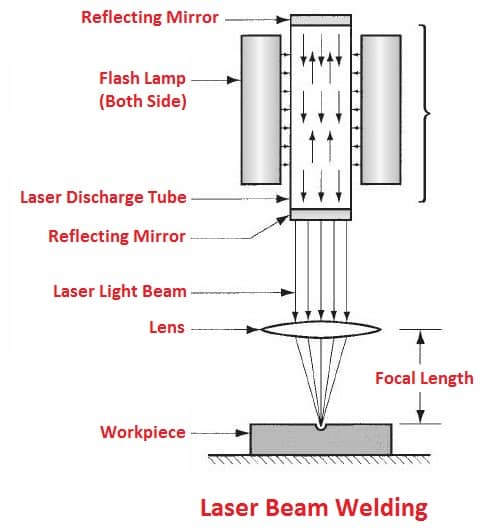In this article, you’ll learn what is laser beam welding how it is done with it’s working principle and types of laser used for this welding it’s applications and more.
Laser Beam Welding
Laser Beam Welding (LBW) is a welding process, in which heat is generated by a high energy laser beam targeted on the workpiece. The laser beam heats and melts the edges of the workpiece, forming a joint.
The energy of a narrow laser beam is highly concentrated at 108-1010 W/cm2, so a weak weld pool is formed very rapidly (for about 10-6 sec).
The solidification of the weld pool surrounded by cold metal occurs as rapidly as the melt. Since the time the molten metal is in contact with the atmosphere is low, there is no contamination and therefore no gradient (neutral gas, flow) is required.
Read also:
In laser welding (LBM) the joint is made either as a sequence of overlapped spot welds or as a continuous weld. Laser welding is used in the electronics, communications and aerospace industries, for the manufacture of medical and scientific equipment, joining small components.
Working Principle of Laser Beam Welding

The laser beam welding works on the principle that when the electrons of an atom are excited by receiving some energy. And then after some time when it returns to its ground state, it emits a photon of light.
The concentration of this emitted photon is increased by the excited emission of radiation and we get high energy focused laser beam. The light amplification by stimulated emission of radiation is named as a laser.
Working of Laser Beam Welding
Initially, the welding machine is setup (between the two metal pieces to join) at the desired location. Later setup, a high voltage power supply is applied to the laser machine to perform an operation.
The lens is used to focus the laser into the area where welding is required. CAM is used to control the speed of the laser and workpiece table during the welding process.
Read also: Types of Welding
It starts the machine’s flash lamp and it emits light photons. The energy of light photons is absorbed by the atoms of ruby crystals and electrons are excited to their higher energy levels. When they return to their low energy state or ground state they emit a photon of light.
This light photon again stimulates the electrons of the atom and produces two photons. This process continues and we get a focused laser beam that is used on the desired location for welding multiple pieces together.
Equipment of Laser Beam Welding
Following are the main equipment of laser beam welding:
- Laser Machine
- CAM (Computer-aided manufacturing)
- CAD (Computer-aided design)
- Shielding gas
- Power source
1. Laser Machine
A laser beam machine is a machine that is used to generate lasers for welding. The main parts of the laser machine are described below.
2. CAM (Computer-aided Manufacturing)
It is a computer-aided manufacturing (CAM) in which a laser machine is combined with a computer to perform the welding process. All control actions are performed during the welding process by CAM. This speeds up the welding process to a great extent.
3. CAD (Computer-aided Design)
The CAD stands for Computer-aided Design. It is a software in which we can design the job for welding. Here the computer is used to design the workpiece and how welding is done on it.
4. Shielding Gas
Shielding gas may be used during the welding process to prevent W/P from oxidizing.
5. Power Source
A high voltage power source is used to the laser machine to produce a laser beam.
Types of Laser Used in the Laser Beam Welding
Following are the main types of laser used in these types of welding:
- Gas laser
- Solid-state laser
- Fibre laser
1. Gas Laser
These types of laser use a mixture of gases for the production of lasers. It contains gases such as nitrogen, helium, and CO2 are used as the lasing medium.
2. Solid-state Laser
In these types of laser use many solids in synthetic ruby crystals (chromium in aluminium oxide), neodymium in glass (Nd: glass) and neodymium in yttrium aluminium garnet (Nd-YAG, the most commonly used).
3. Fibre Laser
The lasing medium in this type of laser is the optical fibre.
Advantages and Disadvantages of Laser Beam Welding
Following are the advantages:
- Easily automated process.
- Controllable process parameters.
- The very narrow weld may be obtained.
- High quality of the weld structure.
- Very small heat-affected zone.
- Dissimilar materials may be welded.
- Very small delicate workpieces may be welded.
- The vacuum is not required.
- Low distortion of the workpiece.
Following are the disadvantages:
- The initial cost is high. The equipment applied in LBW has a high cost.
- The maintenance cost of LBM is high.
- Due to the rapid cooling, fractures can occur in some metals.
- High skilled labours are required to perform LBW.
- The welding thickness is restricted to 19 mm.
- The energy conversion efficiency in LBW is extremely low. It is usually below than 10%.
Applications of Laser Beam Welding Process
- It is prominent in the automotive industry. So, It is used in the area where large volume production is required.
- It is employed for high precision welds. As it does not use any electrode, the final weld will be light but strong.
- The laser welding is also frequently used in making of jewellery.
- However, laser beam welding is used in medical industries to hold metals together on a small scale.
That’s it thanks for reading. If you like our article then please share it with your friends. If you have any questions about this article you can ask in the comments. You can download a PDF of this article by clicking the download button.
Read Next: